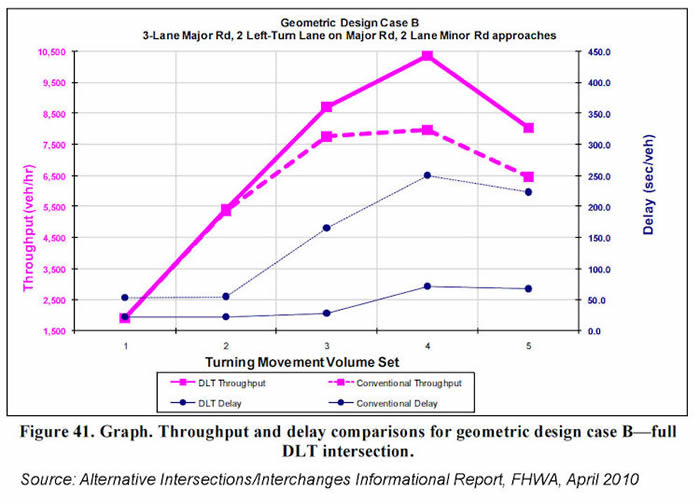
Low cost solutions to congestion!
|
|
|||||||||||||||
|
We are associated with many of the world's leading experts in intersection efficiency and sustainable design.
Innovative Sponsors
Sponsored Links
How To ...
|
The CFI - A Low Cost Solution to Congestion! Simplified depiction of how a CFI works
Simplified depiction of how a CFI works |
|
||||||||
Continuous Flow Intersections
The CFI, also known as a Displaced Left Turn (DLT), and
Crossover Displaced Left (XDL), was first seen in Mexico over 20 years
ago, where there are reportedly upwards of 50. They are catching
on fast in the United States. The nation's third opened in April 2006 in
Baton Rouge, LA for a total cost of $4.4 million. Where vehicles
had been delayed an average of 4-minutes before the project, this was
reportedly reduced to below 1-minute after. The fourth CFI opened in
Salt Lake in 2007, and a month later the fifth opened in St.
Louis. These state DOTs have been so impressed that many more are
under construction, and even more soon will be.
How they work
At a traditional intersection, through traffic must wait while
left turns get their "arrow." The magic of a CFI is that it allows
opposing lefts and throughs to occur at the same time using one signal
at the main intersection, and up to four interconnected mid-block
signals (one for each leg that has the CFI strategy). For example,
while east-west traffic is moving, lefts on the north-south street
cross-over oncoming traffic at a mid-block intersection. Then when
north-south signals turn green, both through and left movements can go
at the same time, because lefts are already on the opposite side of the
throughs.
It looks complex from the air, but has proven simple for drivers to
understand. Controlled simulations suggest that CFIs can reduce
intersection delay between 20-90%, depending upon conditions at the
site. Capacity or throughput also increases by 15-30% or more. Costs are
expected to be about 25-50% higher than building a traditional
intersection, excluding right of way costs.

This 4-Leg CFI in Boise would reduce delay from nearly 3-minutes per vehicle to just 40 seconds, creating a benefit/cost ratio of 11 to 1! Advantages
Disadvantages

Simulation of left-turning vehicles crossing over while the cross street is running. CFIs are "Alternative Intersections"
Continuous Flow Intersections, and "cousins" called the Parallel Flow
Intersection, and the Continuous Flow Interchange, are among a series of
concepts collectively known as Alternative Intersections, Alternative
Intersections, or even Unconventional Intersections. The key trait that
links all Alternative Intersections is that they successfully eliminate
the "left-turn arrow" phase, which otherwise reduces intersection
efficiency considerably.
The Sweet Spot between Intersections and Interchanges
So instead of your choices being either 700-800 vehicles per
hour per lane as the maximum throughput of a typical arterial street, or
constructing a bridge to get 2200 vphpl in one direction, but almost no
added benefit for the cross street, now there are choices low-cost
solutions that land somewhere in the middle and create benefits for all
movements.
Where can I learn more?
The CFI and other Alternative Intersections such as Median
U-Turns, Bowties, Quadrant Intersections, Town Center Intersections,
Roundabouts, Diverging Diamond Interchanges, and others can all be found
at alternativeintersections.org,
where you can search for every Alternative Intersection that exists or
has been planned anywhere in the world (or at least those that our
members are aware of).
This site as well as alternativeintersections.org, are sponsored by www.metroanalytics.com. Links
FHWA's Joe Bared has for years sponsored groundbreaking
research on a number of Alternative Intersections. FHWA's latest findings
on the CFI and other concepts, can be found at:
http://www.fhwa.dot.gov/publications/research/safety/09060/ |
||||||||||